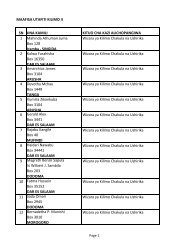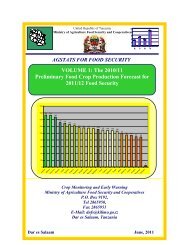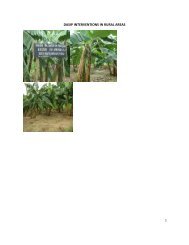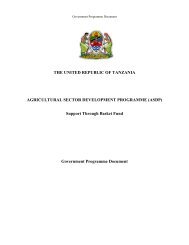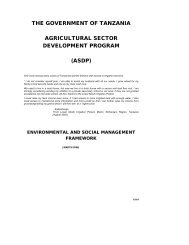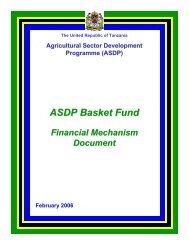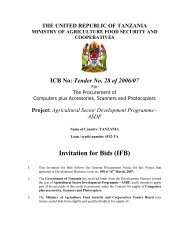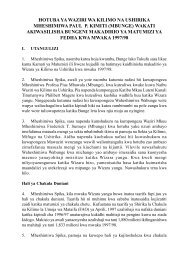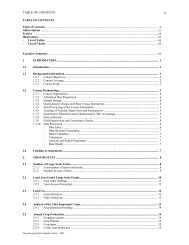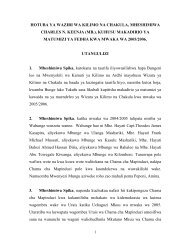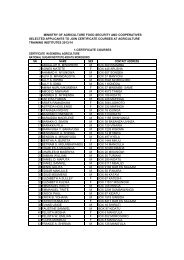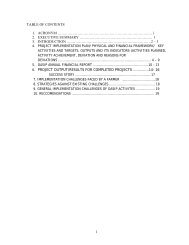(ASDP) - Ministry Of Agriculture, Food and Cooperatives
(ASDP) - Ministry Of Agriculture, Food and Cooperatives
(ASDP) - Ministry Of Agriculture, Food and Cooperatives
- No tags were found...
Create successful ePaper yourself
Turn your PDF publications into a flip-book with our unique Google optimized e-Paper software.
Acronyms<strong>ASDP</strong>ASDSASLMsA-WGBF-SCDADPDALDODEDDFTDPPDPsDSCFAOGoTJICALGAsLGDGLGMDMAFCMITMLFDM&EMISMTEFMKUKUTANBSNSGRPPAFPMO-RALGPSRASRAARDSRLARSRTASWApTANGOTWGURTVAEOVEOWAEOWEOWFTAgricultural Sector Development ProgrammeAgricultural Sector Development StrategyAgricultural Sector Lead MinistriesAgricultural Working Group of Development PartnersBasket Fund Steering CommitteeDistrict Agricultural Development PlanDistrict Agricultural <strong>and</strong> Livestock Development <strong>Of</strong>ficerDistrict Executive DirectorDistrict Facilitation TeamDirector of Policy <strong>and</strong> PlanningDevelopment PartnersDirector of Sector Coordination<strong>Food</strong> <strong>and</strong> Agricultural OrganizationGovernment of TanzaniaJapan International Cooperation AgencyLocal Government AuthoritiesLocal Government Development GrantLocal Government Monitoring Database<strong>Ministry</strong> of <strong>Agriculture</strong>, <strong>Food</strong> Security <strong>and</strong> <strong>Cooperatives</strong><strong>Ministry</strong> of Industry <strong>and</strong> Trade<strong>Ministry</strong> of Livestock <strong>and</strong> Fisheries DevelopmentMonitoring <strong>and</strong> EvaluationManagement Information SystemMedium-Term Expenditure FrameworkMkakati wa Kukuza Uchumi na Kupunguza Umasikini TanzaniaNational Bureau of StatisticsNational Strategy for Growth <strong>and</strong> Reduction of PovertyPerformance Assessment FrameworkPrime Minister’s <strong>Of</strong>fice- Regional Administration <strong>and</strong> Local GovernmentPermanent SecretaryRegional Administrative SecretaryRegional Agricultural AdviserRoutine Data SystemRegional Livestock AdviserRegional SecretariatRegional Trade AdviserSector Wide ApproachTanzania Non-Governmental OrganizationsThematic Working GroupUnited Republic of TanzaniaVillage Agricultural Extension <strong>Of</strong>ficerVillage Executive <strong>Of</strong>ficerWard Agricultural Extension <strong>Of</strong>ficerWard Executive <strong>Of</strong>ficerWard Facilitation Team
1. ITRODUCTIO1.1 Background<strong>ASDP</strong> Monitoring <strong>and</strong> Evaluation FrameworkThe Government of Tanzania has adopted the Agricultural Sector Development Strategy (ASDS) since2001. The objective of the ASDS is to achieve a sustained agricultural growth rate of 5 to 6 percent perannum primarily through the transformation from subsistence to commercial agriculture. TheAgricultural Sector Development Program (<strong>ASDP</strong>), developed in 2003, is a long-term processdesigned to implement the ASDS based on a Sector Wide Approach (SWAp). It establishes operationallinkages between the Agricultural Sector Lead Ministries (ASLMs) 1 <strong>and</strong> other stakeholders. It forgesthe connection between dem<strong>and</strong>-driven, field-based district planning processes, <strong>and</strong> the mobilization<strong>and</strong> monitoring of national <strong>and</strong> international investment in agriculture. With the launching of the<strong>ASDP</strong>, there is a growing interest in establishing a sector-wide monitoring <strong>and</strong> evaluation (M&E)system.In September 2007, the first <strong>ASDP</strong> M&E framework which outlines how the M&E for the agriculturalsector under the <strong>ASDP</strong> is conducted was developed <strong>and</strong> approved by the Committee of ASLMsDirectors. The framework was developed by the <strong>ASDP</strong> M&E Thematic Working Group (TWG) whichis composed of the officials of both the Government of Tanzania <strong>and</strong> Development Partners (DPs). Asfor the former, M&E specialists, Management Information System (MIS) experts <strong>and</strong> statisticianswere appointed to be members of the TWG. Among the DPs who participated in the Working Groupare FAO, Irish Aid, JICA, <strong>and</strong> World Bank. In developing the M&E framework, a lot of consultationswere made with officials of Local Government Authority (LGA) <strong>and</strong> Regional Secretariats (RSs).Subsequently, the <strong>ASDP</strong> M&E Guideline which delineates actions to be taken by each stakeholder for<strong>ASDP</strong> M&E has been developed <strong>and</strong> approved by the Committee of ASLMs Directors. Both theframework <strong>and</strong> guideline have been disseminated to all the regions / districts.It is now three years since the first M&E framework was adopted; it is high time to revise theframework to adjust to the implementation made in the <strong>ASDP</strong> since then. The revised M&Eframework incorporates, among others, new short-listed indicators <strong>and</strong> improvement in theAgricultural Routine Data System. It also explains an envisaged M&E system of the <strong>ASDP</strong>. Some ofthem have already been implemented. Others are not in place yet, <strong>and</strong> the M&E TWG is currentlyworking toward full operationalization of the framework.1.2 ObjectivesThe overall objective of the M&E framework is to outline the M&E system for the agricultural sectorunder the <strong>ASDP</strong>. The M&E system will provide information that will enable stakeholders to trackprogress <strong>and</strong> enhance informed decision-making at all levels in the implementation of the <strong>ASDP</strong>.The specific objectives of the <strong>ASDP</strong> M&E system are to:• Promote the importance of systematic data/information collection <strong>and</strong> utilization of M&Eresults in the planning of the <strong>ASDP</strong>;• Strengthen the M&E capacity of <strong>ASDP</strong> stakeholders to collect, analyze <strong>and</strong> usedata/information; <strong>and</strong>• Enhance the underst<strong>and</strong>ing of trends <strong>and</strong> changes in the levels of agricultural development,food security, <strong>and</strong> poverty reduction in the country over time.1 The ASLMs are the <strong>Ministry</strong> of <strong>Agriculture</strong>, <strong>Food</strong> Security <strong>and</strong> <strong>Cooperatives</strong> (MAFC), <strong>Ministry</strong> of Livestock<strong>and</strong> Fisheries Development (MLFD), <strong>Ministry</strong> of Industry <strong>and</strong> Trade (MIT) <strong>and</strong> Prime-Minister’s <strong>Of</strong>fice -Regional Administration <strong>and</strong> Local Government (PMO-RALG).1
1.3 Guiding PrinciplesThe <strong>ASDP</strong> M&E will be undertaken under the following guiding principles.• Harmonized with other government M&E systems, such as MKUKUTA II.• Results-based management adopted.• Existing mechanisms of data collection used.• Using the baseline data / information as benchmark• Ad-hoc surveys avoided as much as possible.• Starting as simple as possible.• Starting from the current situation.• Incremental in capacity development.• Recognizing the dynamic nature of the <strong>ASDP</strong>.• Flexible in revising <strong>ASDP</strong> M&E framework.1.4 Scope of the M&E Framework 2The M&E framework covers the following scopes.• Performance measurement of the <strong>ASDP</strong>• Data collection, reporting <strong>and</strong> reviews• Institutional arrangements for <strong>ASDP</strong> M&E.2 M&E undertaken for each project in District Agricultural Development Plans (DADP) is not presented in thisdocument.2
OverallgoalContribute to national economy, household income <strong>and</strong> export earningsImpactPurpose, strategicobjectives1. Rural poverty reduced <strong>and</strong> household food security in rural areas improved3. Agricultural production increased <strong>and</strong>productivity improved2. Farm income increased4. Agricultural profitability improvedFarmers' use of technology <strong>and</strong> infrastructure improvedOutcomeStrategic areas6. Physicalagriculturalinfrastructureimproved5. Private sector investment in agriculture enhanced7. Agriculturalservicesimproved8. Agriculturalmarketingsystemstrengthened9. Institutionalframeworkstrengthened10. Cross-cutting<strong>and</strong> crosssectoral issuesmainstreamedInterventionsDem<strong>and</strong>-drivenproductioninfrastructureconstructed orrehabilitated:Clientorientedagriculturalservices inplace:Agriculturalmarketinginstitutionimproved:Activities<strong>ASDP</strong>coordinationframeworkestablished <strong>and</strong>integrated:Cross sectoralissues ofagriculture <strong>and</strong>livestockdevelopmentaddressedOutputProcessFinancial, human <strong>and</strong> physical investmentsInputFigure 2.3 Structure of impact, outcome <strong>and</strong> output statements <strong>and</strong> their relationship with <strong>ASDP</strong>Note: Dashed boxes are ASDS overall goal, purpose, strategic objectives, strategic areas <strong>and</strong> interventions.5
Table 2.1 <strong>ASDP</strong> Short-listed impact, outcome <strong>and</strong> output indicators (as of December 2010)Impact (IM)IndicatorsFrequencyDistrictDisaggregationRegionNationalDatasource1. Real agricultural GDP growth rate per annum Annual √ NBS2. Headcount ratio in rural areas – basic needs poverty line Periodical √ √NBS(HBS)3. Value of agricultural exports Annual √ TRA1. <strong>Food</strong> self-sufficiency ratio Annual √ √ MAFCOutcome (OC)2. Production <strong>and</strong> productivity ofcrops <strong>and</strong> livestock.3. Proportion of smallholderhouseholds using improvedtechnologiesMaizePaddyBeefMilkImproved seedChemical fertilizersIrrigated farmingImproved dairyErosion control4. Amount of lending to the agricultural sector by privatebanksPeriodical √ √ √NBS(NSCA),Annual √ √ √ MLFDPeriodical √ √ √NBS(NSCA)Annual √ BOT5. Proportion of smallholder households using mechanization Periodical √ √ √6. Ratio of processed exported agricultural products to totalexported agricultural products7. Number of smallholder households participating incontracting production <strong>and</strong> out-growers schemesNBS(NSCA)Annual √ TRAAnnual √ √ √ LGAs8. Proportion of LGAs that qualify to receive top-up grants Annual √9. Proportion of LGAs that qualify to receive performancebonus10. Proportion of farmers having visits from public or privateextension staffAnnualPeriodical √ √ √√PMO-RALGPMO-RALGNBS(NSCA)11. Amount of fertilizer consumed [PAF] Annual √ MAFC12. Number of Households using irrigation infrastructure(members of Irrigation Organizations) [PAF]Annual √ MAFC6
Dams1. Number ofagriculturalproductioninfrastructureCharco damsCattle dipsOxenization centresAnnual √ √ √LGAs /MLFDVeterinary clinicsLivestock secondary marketsAnnual √ √ √MLFD /LGALivestock primary marketsMeat processing plants2. Number ofagriculturalmarketinginfrastructure <strong>and</strong>machineryFeeder roadsLivestock holding groundsAbattoirsSlaughter housesSlaughter slabsHide <strong>and</strong> skin shedsAnnual √ √ √ LGAsOutput (OP)Pulperies / ginneries / shellingMilling machinesOil extracting machine3. Number of extension officers trained on improvedtechnological packages4. Number of SACCOS, members <strong>and</strong> loans provided foragricultureAnnual √ √ √ LGAsAnnual √ √ √ LGAs5. Number of agricultural marketing regulations <strong>and</strong>legislation in placeAnnual√MIT,MAFC,MLFD6. Number of markets where wholesale or retail prices arecollectedAnnual √ MIT7. Number of <strong>ASDP</strong> Basket Fund Steering Committeemeetings heldAnnual√<strong>ASDP</strong>Secretariat8. Proportion of DADP quarterly physical <strong>and</strong> financialprogress reports submitted on timeAnnual√PMO-RALG9. Proportion of female members of Planning <strong>and</strong> FinanceCommittee10. Number of research projects related to crops, livestock <strong>and</strong>marketing/processing, conducted through ZARDEFAnnual √ √ √ LGAsAnnual √ ASLMs7
3. DATA COLLECTIO, REPORTIG AD REVIEWS3.1 Data Collection <strong>and</strong> reporting3.1.1 Type of data for <strong>ASDP</strong> M&EAgricultural information used for <strong>ASDP</strong> M&E can be broadly categorized as shown in Table 3.1.1.Projectrelatedinformation(DADP,etc.)Table 3.1 Type of agricultural data / informationData typesExamples1-1. Expenses, manpower, equipment used for each DADP projectInput (interventions)1-2. Area (ha) of irrigation schemes developed / rehabilitated by DADP/Output DIDF projects, Number of cattle dip rehabilitated in a DADP project, Number of farmers trained in a DADP project, etc.1-3. Number of farmers using improved technologies due to a DADPOutcome/ project,impact Increase in crop production as a result of a DADP / DIDF project, Improvement in crop yield as a result of a DADP project, Decrease in animal mortality rate due to a DADP project, Increase in income of a farmer due to a DADP project, etc.2-1. Input Total agricultural budget for a district, Total number of extension officers in a district / region, Total number of vehicles / motorcycles in a district, etc.2-2. Total area under irrigation schemes (developed) in a district,Output Total number of certain agricultural machinery / implements in adistrict, Total number of cattle dips available in a district, Total number of farmers trained in a district,2-3. Number of farmers using mechanization in a district /region /nation,Outcome/ Total amount of crop production <strong>and</strong> acreage in a district,impact Total amount of meat production in a district, Total number of farmers using new technologies, Overall changes in farmers’ income Value of agricultural export2.Agriculturalperformanceinformation(village,district,regional,nationallevel)3.1.2 Project-related informationThe first type of agricultural information is project-related ones. Information on input <strong>and</strong> output (1-1<strong>and</strong> 1-2) of each DADP project are collected by respective project committee or DFT members <strong>and</strong> issummarized in the DADP Physical <strong>and</strong> Financial Quarterly Progress Report in each LGA. The reportis submitted to respective regions, where they are consolidated into a regional report. The report issubmitted to the Department of Sector Coordination (DSC), PMO-RALG. The DSC officialsconsolidate them into a national report <strong>and</strong> submit it to the <strong>ASDP</strong> Secretariat, which in turn prepares<strong>ASDP</strong> Quarterly Progress Reports by incorporating it with the information on <strong>ASDP</strong> NationalComponent. The report is then submitted to the Committee of ASLMs Directors <strong>and</strong> <strong>ASDP</strong> BasketFund Steering Committee.To capture outcome information of each DADP project (1-3), a national st<strong>and</strong>ard format is beingdeveloped jointly by the DADP Planning <strong>and</strong> Implementation TWG <strong>and</strong> <strong>ASDP</strong> M&E TWG at present.The current plan is for LGAs to fill out the format for each project once a year <strong>and</strong> submit it torespective region. Regional officials consolidate them into a regional report <strong>and</strong> submit it to PMO-RALG. In PMO-RALG, the reports are consolidated into a national report, which is submitted to the8
Committee of ASLMs Directors <strong>and</strong> <strong>ASDP</strong> Basket Fund Steering Committee as an annex to the 4 thquarter DADP Physical <strong>and</strong> Financial Progress Report. The flow of input, output <strong>and</strong> outcome DADPproject information is depicted in Figure 3.1.Figure 3.1 Flow of input, output <strong>and</strong> outcome DADP project informationIt is important to note that outcome information for each DADP project (intervention) is different fromagricultural performance information at village / district levels (2-3) in that, the former addresses thechanges at project level while the latter is concerned with the changes at village or district level as awhole. The difference is depicted in Figure 3.2. As seen in the figure, the project outcomes correspondto individual projects while the performance information represents the whole district covering bothproject-implemented villages/wards <strong>and</strong> non-project-implemented ones.Figure 3.2 Project level outcome <strong>and</strong> village/district level outcome9
3.1.3 Agricultural performance informationThe second type is agricultural performance information at village / district / region / national level(type 2). The financial information (2-1) is transmitted using the normal government system asspecified by the <strong>Ministry</strong> of Finance.As for the output <strong>and</strong> outcome information (2-2 <strong>and</strong> 2-3), some sub-sectors have their unique systemsin which the data are collected at LGAs or zones <strong>and</strong> transmitted to national level individually. Theyinclude, but not limited to, the following.<strong>Food</strong> forecasting <strong>and</strong> early warning (food security concerns)Livestock disease surveillance <strong>and</strong> diagnosis (livestock disease control)Marketing report (retail <strong>and</strong> wholesale prices for crops <strong>and</strong> livestock)Zonal irrigation reportFish catch assessment survey reportAgricultural cooperative reportResearch institute reportOther general agricultural information are collected <strong>and</strong> transmitted through the agricultural RoutineData System. Most data in this type are originated at village / ward levels, which are collected <strong>and</strong>recorded by village / ward agricultural extension officers (VAEO / WAEO). St<strong>and</strong>ard reporting forms(monthly, quarterly <strong>and</strong> annual) for VAEO / WAEO (VAEO / WAEO format) have been developed bythe <strong>ASDP</strong> M&E TWG. The information submitted by WAEO is consolidated at district level, whichare in turn transmitted to ASLMs via regions using computer software called Local GovernmentMonitoring Database 2 (LGMD2) (quarterly <strong>and</strong> annual). The LGMD2 uses national st<strong>and</strong>ard formscalled Integrated Data Collection Format 3 .The VAEO/WAEO format, Integrated Data Collection Format <strong>and</strong> LGMD2 collectively consist of theagricultural Routine Data System (ARDS).Another method to collect outcome agricultural performance information (2-3) is agricultural surveysundertaken primarily by National Bureau of Statistics (NBS) <strong>and</strong> ASLMs. Key surveys concerning<strong>ASDP</strong> are summarized in Table 3.2.Table 3.2 Types, frequency <strong>and</strong> disaggregation of surveys concerning agricultureTypes of survey Frequency Geographical disaggregationNational Sample Census of<strong>Agriculture</strong> (NSCA)5 years (2002/03, 07/08) District, Region, NationalNational Panel Survey (NPS) Every year* (2008/09, 2010/11) NationalHousehold Budget Survey (HBS) 5 to 7 years (2000/01, 2007)National Population <strong>and</strong> HousingCensusNational,Rural / Urban / DSM10 years (2002) Village through national* Although NPS is planned to be undertaken every year, it was not implemented in 2009/10 after itsinitial implementation in 2008/09. The second round is being conducted in 2010/11.The agricultural surveys are said to provide more reliable information on <strong>ASDP</strong> outcomes than ARDSbecause the former directly asks farmers who are r<strong>and</strong>omly sampled while the latter depends onobservations of VAEO/WAEO <strong>and</strong> information from the key informants. On the other h<strong>and</strong>, a keyshortcoming of these surveys is that they are implemented with a long interval (i.e., 5 years in the caseof NSCA) except for NPS. Agricultural performance in Tanzania is greatly influenced by weatherconditions, which vary largely from year to year. Thus, it is important to have surveys on an annualbasis. NPS, if implemented annually, is able to provide annual agricultural information, but it is notcertain if it is feasible to undertake a big survey like NPS every year. In addition, even if it is3 Both VAEO/WAEO format <strong>and</strong> Integrated Data Collection Format are attached to the <strong>ASDP</strong> M&E guideline.10
undertaken every year, the estimates are available at national level only.Figure 3.3 depicts the flow of input, output <strong>and</strong> outcome agricultural performance information.Figure 3.3 Flow of input, output <strong>and</strong> outcome agricultural performance information3. 2 Assessment <strong>and</strong> ReviewsAll the reports / survey results explained in the previous section are used for the assessment <strong>and</strong>reviews of the <strong>ASDP</strong>. There are primarily three types of assessment / reviews concerning <strong>ASDP</strong> asexplained below.3.2.1 Types of Reviews(1) Joint Implementation ReviewThe Joint Implementation Review is conducted jointly by the ASLMs <strong>and</strong> DPs every year. The overallpurpose of the review is to assess the progress of the <strong>ASDP</strong>, to evaluate implementation progress, <strong>and</strong>to identify constraints <strong>and</strong> hence suggest actions to be taken for smooth implementation of theprogramme. The review teams visit several districts <strong>and</strong> regions annually to observe the status of<strong>ASDP</strong> implementation <strong>and</strong> examine achievement <strong>and</strong> challenges with stakeholders such asgovernment officials <strong>and</strong> farmers. The review provides input to the key <strong>ASDP</strong> committees, which arethe <strong>ASDP</strong> Basket Fund Steering Committee <strong>and</strong> the Committee of ASLMs directors.(2) Agricultural Sector Review <strong>and</strong> Public Expenditure ReviewThe Agricultural Sector <strong>and</strong> Public Expenditure Reviews (ASR/PER) are conducted by the ASLMs,private sector, civil society <strong>and</strong> DPs on an annual basis. The Review assesses agricultural sectorperformance <strong>and</strong> constraints. It also analyzes key policies, institutional reforms <strong>and</strong> their link to theperformance of <strong>ASDP</strong>. The information/data collected <strong>and</strong> analyzed in the previous mechanism will beused as a key input for the review. The reviews provide input to the key <strong>ASDP</strong> committees such as the<strong>ASDP</strong> Basket Fund Steering Committee <strong>and</strong> the Committee of ASLMs directors.(3) LGDG Reviews / AssessmentsThere are reviews / assessments which are implemented under the Local Government Development11
Grant (LGDG) system which is undertaken by the PMO-RALG. The LGDG reviews are also relevantto the <strong>ASDP</strong> implementation because DADP funds are disbursed to each LGA using the channels ofthe LGDG system. The reviews under the LGDG system include Quarterly Technical Reviews <strong>and</strong>annual LGA assessment. The results of these reviews are also used for <strong>ASDP</strong> M&E.3.2.2 Schedule of reviews <strong>and</strong> key committee meetingsIn addition to specific reviews explained in the previous section, there are several committee meetingswhich also play an important role in <strong>ASDP</strong> M&E. Figure 3.4 shows a typical annual calendar of thesereviews / meetings. They may change depending on the circumstances.Reviews / Committee meetings Jul Aug Sep Oct Nov Dec Jan Feb Mar Apr May Jun<strong>ASDP</strong> Joint Implementation ReviewAgricltural Sector Review <strong>and</strong> Public Expenditure ReviewQuarterly Technical Review (LGDG system)Annual LGA assessment (LGDG system)<strong>ASDP</strong> Basket Fund Steering CommitteeCommittee of ASLMs DirectorsFigure 3.4 Schedule of the key <strong>ASDP</strong> reviews <strong>and</strong> committee meetings12
Institution /CommitteeRegionalSecretariatsDistrictsWardsVillages / mtaaDevelopmentPartnersCivil SocietiesMajor Responsibilities in M&E• Provide technical facilitation to LGAs on reportpreparation.• Monitor DADPs implementation <strong>and</strong> prepare supervisionreports.• Provide feedback to LGAs on their reports.• Consolidate DADP Physical <strong>and</strong> Financial QuarterlyProgress Reports <strong>and</strong> submit it to PMO-RALG.• Organize annual DADP review meetings.• Approve the data submitted by LGAs through LGMD2.• Collect filled-in VAEO/WAEO format <strong>and</strong> consolidatethem to prepare district level report.• Submit district level information to regions / ASLMs usingLGMD2.• Monitor DADP activities implemented in the district.• Collect DADP project input, output <strong>and</strong> outcomeinformation <strong>and</strong> enter them in DADP Physical <strong>and</strong>Financial Quarterly Progress Reports.• Monitor village activities.• Complete the VAEO/WAEO format in collaboration withVAEO <strong>and</strong> submit it to districts• Monitor village activities.• Complete VAEO/WAEO format in collaboration withVEOs <strong>and</strong> submit it WAEO.• Monitor agricultural sector policies <strong>and</strong> programmeimplementation.• Participate in <strong>ASDP</strong> reviews <strong>and</strong> TWGs.• Monitor the implementation <strong>and</strong> progress of <strong>ASDP</strong>.• Provide information for <strong>ASDP</strong> M&E.Responsibleofficer• RegionalAdministrativeSecretary• DistrictExecutiveDirector• Ward Executive<strong>Of</strong>ficer• VillageExecutive<strong>Of</strong>ficer• Chairman ofAgriculturalWorking Group• Chairman ofTANGO14
Outputs: Specific tangible products <strong>and</strong> services that emerge from processing inputs throughprogramme or project activities. These are necessary to achieve the objectives of a programme orproject. It is also the measurable results of activities. Example: agricultural extension servicesprovided to rice farmers.Process: Process means activities carried out by using inputs. It shows activities that have to beundertaken by the project in order to produce the outputs. Activities should be adequate to reflect<strong>and</strong> outline the indented strategy to accomplish each output.Stakeholders: People, groups or entities that have a role <strong>and</strong> interest in the objectives <strong>and</strong>implementation of a programme/project. They include the community whose situation theprogramme seeks to change; project field staff who implement activities; project <strong>and</strong> programmemanagers who oversee implementation; donors <strong>and</strong> other decision-makers who decide the courseof action related to the programme; <strong>and</strong> supporters, critics <strong>and</strong> other persons who influence theprogramme environment. In participatory evaluation, stakeholders assume an increased role in theevaluation process as question-makers, evaluation planners, data gatherers <strong>and</strong> problem solvers.Supervision: Supervision is the process of guiding <strong>and</strong> helping people to improve their ownperformance.16
AEX 1. Long-listed Indicators (Draft)Indicators in bold are short-listed indicators.Impact indicatorsComponent Indicator Data sourceContribute to national economyImpact Real GDP growth rate per annum (Agricultural sector, Livestock Sub-Sector) [MKUKUTA] NBSContribute to household incomeImpact Headcount ratio – basic needs poverty line [MKUKUTA] NBS (HBS)Contribute to export earningsImpact Value of agricultural exports TRA1. Rural poverty reduced <strong>and</strong> household food security in rural areas improvedComponent Indicator / Statement Data sourceOutcome Proportion of households who take no more than one meal per day [MKUKUTA]1.1 <strong>Food</strong> security policies developedOutput <strong>Food</strong> security policy in placeOutput Number of councils with by-laws which sets the minimum acreage of food crops for each household1.2 Plans for addressing household food insecurity promotedOutput Number of plans addressing household food insecurityOutput Number of households that have storage facilities2. Farm income increasedComponent Indicator Data sourceOutcome Production <strong>and</strong> productivity of crops <strong>and</strong> livestock NBS (HBS)3. Agricultural production increased <strong>and</strong> productivity improvedComponent Indicator Data sourceOutcome <strong>Food</strong> self-sufficiency ratio [MKUKUTA] MAFC18
Outcome Proportion of districts reported to have food shortages [MKUKUTA]Outcome Farmers agricultural production <strong>and</strong> productivity increased [MKUKUTA]4. Agricultural profitability improvedComponent Indicator / Statement Data sourceOutcome Share of farm-gate prices to wholesale, retail <strong>and</strong> export prices5. Private investment in agricultural sector enhancedComponent Indicator / Statement Data sourceOutcome Flow of private funds into agricultural <strong>and</strong> livestock sectors TIC5.1 Policies <strong>and</strong> regulations that attract private investment in place (tax, budget allocation, information, laws)Output Number of agricultural investment policies <strong>and</strong> regulations in placeOutput Number of procedures <strong>and</strong> processes for investors reviewedOutput Number of agricultural investment incentives offered5.2 Effective procedures <strong>and</strong> processes to acquire l<strong>and</strong> for agricultural investment in placeOutput Proportion of l<strong>and</strong> applications approved within 90 daysOutput Number of LGAs in which agricultural l<strong>and</strong> survey has been completedOutput Number of agricultural l<strong>and</strong> survey experts in each district6. Physical agricultural infrastructure improvedComponent Indicator Data sourceOutcome Proportion of households using physical agricultural infrastructure (dams, irrigation, wells, storage )Outcome Volumes of marketed agricultural products6.1 Constructed or rehabilitated dem<strong>and</strong>–driven agricultural production infrastructureOutput umber of agricultural production infrastructure existing <strong>and</strong> in operation LGAsInput % of budget (GoT <strong>and</strong> DPs) on agricultural production infrastructure6.2 Constructed or rehabilitated dem<strong>and</strong>-driven agricultural marketing infrastructureOutput umber of agricultural marketing infrastructure <strong>and</strong> machinery existing <strong>and</strong> in operation LGAsInput % of budget (GoT <strong>and</strong> DPs) on agricultural marketing infrastructure19
7. Agricultural services improvedComponent Indicator / Statement Data sourceOutcome Proportion of farmers satisfied with public <strong>and</strong> or private agricultural services (Extension, information, research, finance)Outcome Proportion of households accessing public <strong>and</strong> or private agricultural services (Extension, research)Outcome Proportion of smallholder households using improved technologies (improved seeds, pesticides/fungicides, chemical NBS (NSCA)fertilizers, irrigated farming, improved beef, improved dairy cow <strong>and</strong> erosion control)Outcome % of smallholders who accessed formal credit (commercial banks <strong>and</strong> cooperatives (SACCOS/SACAS)) for agriculturalpurposes [MKUKUTA]Outcome Amount of loan provided by commercial banks <strong>and</strong> cooperatives in the agricultural sectorOutcome Proportion of smallholder households using mechanization (power tillers, tractors, combine harvesters <strong>and</strong> oxenization) NBS (NSCA)7.1 Client-oriented agricultural services (Extension, information, research, finance) in placeOutput Number of client-oriented programmes conducted by research institutes increasedOutput Number of active private agricultural service providersOutput Number of farmers trained on new technologiesOutput Number of technological packages promoted <strong>and</strong> disseminated (new varieties of seeds, pesticides, improved breeds, newanimal drugs)Input % of budget (GoT <strong>and</strong> DPs) on agricultural research <strong>and</strong> technology development7.2 Dem<strong>and</strong>-driven agricultural extension system strengthenedOutput Ratio of farmers to extension officersOutput umber of extension officers trained on improved technological packages LGAsOutput Number of private agricultural service providers trainedInput % of budget (GoT <strong>and</strong> DPs) for A-EBG. (Agricultural Extension Block Grant)7.3 Dem<strong>and</strong>-driven agricultural training strengthenedOutput Number of farmers trainedOutput Number of training institutes that have reviewed <strong>and</strong>/or improved their curriculaInput % of budget (GoT <strong>and</strong> DPs) on agricultural training institutes7.4 Financial services improvedOutput Value of loans provided by SACCOs for agriculture LGAsOutput Number of members of rural micro finance institutions (SACCOS/SACAS) trainedInput % of budget (GoT <strong>and</strong> DPs) for micro finance outreach programme20
8. Agricultural marketing system strengthenedComponent Indicator / Statement Data sourceOutcome Value of agricultural product marketed increased (through processing)Outcome Ratio of processed exported agricultural products to total exported agricultural products TRAOutcome Proportion of farmers accessing market informationOutcome Proportion of smallholder households participating in contracting production <strong>and</strong> out-growers schemes [MKUKUTA] LGAs8.1 Agricultural marketing institutions improvedOutput umber of agricultural marketing regulations <strong>and</strong> legislation in place MITOutput Number of st<strong>and</strong>ards reviewed <strong>and</strong> implementedInput % of MIT budget for marketing <strong>and</strong> processing8.2 Cross-border trade legalized <strong>and</strong> promotedOutput Number of barriers to cross-border trade removedOutput Average number of days by product it takes to complete export procedures8.3 Market information improvedOutput Number of client-oriented information systems <strong>and</strong> centers in placeOutput umber of markets where wholesale <strong>and</strong> retail prices are collected MITOutput Number of media that provide market information8.4 Value chain improvedOutput Proportion of agricultural <strong>and</strong> livestock products with value chain identified (traceability)8.5 Marketing skills strengthenedOutput Number of persons trained on agribusiness8.6 Partnership promotedOutput Number of sensitization seminars on out-grower <strong>and</strong> contract-farming schemes conductedOutput Proportion of villages covered by telephone networkInput % of budget allocated for out-grower <strong>and</strong> contract-farming schemes outreach programme8.7 Access to input improvedOutput Number of stockists trainedOutput Number of licensed stockists21
9. Institutional framework strengthenedComponent Indicator / Statement Data sourceOutcome Proportion of LGAs that qualify to receive top-up grants PMO-RALGOutcome Proportion of LGAs that qualify to receive performance bonus PMO-RALGOutcome Increased performance of stakeholders in implementation of the <strong>ASDP</strong>9.1 <strong>ASDP</strong> coordination framework established <strong>and</strong> integratedOutput umber of Inter-Ministerial Coordination Committee (ICC) meetings held <strong>ASDP</strong> SecretariatOutput Number of <strong>ASDP</strong> Basket Fund Steering Committee meetings heldOutput Number of ASLMs Directors Committee meetings heldOutput Number of activities carried out by <strong>ASDP</strong> Secretariat referencing ToRInput Number of officers in the <strong>ASDP</strong> SecretariatInput % of budget allocated to the <strong>ASDP</strong> Secretariat9.2 Capacity of ASLMs, regional secretariat, LGAs strengthenedOutput Ratio of posts filled by qualified staffOutput Number of officers trained on <strong>ASDP</strong>Output Number of monitoring reports submitted on timeOutput Proportion of quarterly progress reports submitted on time Regions/ASLMsOutput % of LGA department (DALDO) having at least one vehicleOutput % of WAEO having a motorbikeOutput % of VAEO having a bicycleInput % of budget allocated for A-CBG (Agricultural Capacity Building Grant)9.3 Farmers organizations promotedOutput Number of farmer groups trainedOutput Number of farmer groups provided with funds, equipment <strong>and</strong> materialsInput % of budget allocated for farmers field school (FFS) programme9.4 Civil society organizations promotedOutput Number of civil society organizations sensitized on <strong>ASDP</strong>Input % of budget allocated for civil society outreach programme22
10. Cross-cutting <strong>and</strong> cross sectoral issues mainstreamedComponent Indicator / Statement Data sourceOutcome Existence of other sectors’ plans supporting agriculture developed <strong>and</strong> implementedOutcome Existence of other sectors’ plans in agricultural plansOutcome Proportional of HIV/AIDS affected households that have adopted coping strategies10.1 Cross sectoral issues of agriculture <strong>and</strong> livestock development addressedOutput Number of households that have access to potable water within 400mOutput Number of villages covered by electricity services10.2 Spread <strong>and</strong> impact of HIV/AIDS <strong>and</strong> malaria minimizedOutput Number of seminars to enhance awareness on HIV/AIDS <strong>and</strong> malaria10.3 Gender issues mainstreamed in agricultural development plansOutput Number of seminars to enhance awareness on genderOutput Proportion of female members of Planning <strong>and</strong> Finance Committee LGAsOutput Number of agricultural technologies developed to reduce the workload of women10.4 Environmental management improvedOutput Number of seminars on environmental management conductedOutput Number of soil <strong>and</strong> water conservation technologies developedOutput Number of projects under <strong>ASDP</strong> with environmental impact assessment plans23
AEX 2.Short-listed IndicatorsIMPACT IDICATORSImpact indicator 1DefinitionRationaleFrequency of reportingImpact statement concernedData sourcesResponsibility for datacollectionDisaggregationRiskCommentsImpact indicator 2DefinitionRationaleFrequency of reportingImpact statement concernedData sourcesResponsibility for datacollectionDisaggregationRiskCommentsImpact indicator 3DefinitionRationaleFrequency of reportingImpact statement concernedData sourcesResponsibility for datacollectionDisaggregationRiskCommentsAgricultural GDP growth rate per annum (agricultural sector, crop <strong>and</strong>livestock sub-sectors)Difference between GDP (of the particular sector) in year x+1 <strong>and</strong> GDP inyear x (at constant prices), expressed as percentage of the GDP in year x.The indicator is used to monitor the growth of sectors of the economy inthe country.AnnualContribute to national economyNBS National AccountNBSNationalNo riskThis is a MKUKUTA indicator.Headcount ratio in rural areas – basic needs poverty lineThe proportion of the population who live in households for which theconsumption expenditure falls below an internationally agreed poverty linefor basic needs requirements.The indicator allows for monitoring the proportion of the nationalpopulation that is considered poor using the national st<strong>and</strong>ards.PeriodicalContribute to household incomeHousehold Budget Survey (HBS)NBSRegional, NationalThe survey is supposed to be conducted every five years, but there havebeen longer intervals.This is a MKUKUTA indicator.Value of agricultural exportThe value (in US dollar) of the export of agricultural products fromTanzania to the rest of the world.An improvement in productivity <strong>and</strong> quality in agriculture is expected tolead to an increase in the value of exports of agricultural products <strong>and</strong>contributes to foreign currency earnings.AnnualContribute to export earningsTRATRANationalNo riskThe same product categories by HS code shown in “Annex to Table IM3”should be used in the subsequent years.24
OUTCOME IDICATORSOutcome indicator 1DefinitionRationaleFrequency of reportingOutcome statement concernedData sourcesResponsibility for datacollectionDisaggregationRiskCommentsOutcome indicator 2DefinitionRationaleFrequency of reportingOutcome statement concernedData sourcesResponsibility for datacollectionDisaggregationRiskComments<strong>Food</strong> self-sufficiency ratioThe percentage ratio of gross domestic production to gross domestic foodrequirements.The indicator measures whether national food production meets grossfood requirements. The same also applies at the regional level where theindicator tells the extent to which a region’s annual food productionsatisfies its population needs. At 100% self-sufficiency ratio (SSR) thefood produced in the current year will be equal to food required duringthe next consumption year. A situation where food produced is in therange of 100 - 120% is considered self-sufficient. When the SSR is 120%<strong>and</strong> above the situation is considered surplus.• SSR
Outcome indicator 3DefinitionRationaleFrequency of reportingOutcome statement concernedData sourcesResponsibility for datacollectionDisaggregationRiskCommentsOutcome indicator 4DefinitionRationaleFrequency of reportingOutcome statement concernedData sourcesResponsibility for datacollectionDisaggregationRiskCommentsOutcome indicator 5DefinitionRationaleFrequency of reportingProportion of smallholder households using improved technologiesProportion of smallholder households using improved technologies:- Improved seeds,- Chemical fertilizer,- Irrigation,- Improved dairy- Erosion controlIt describes the farming husb<strong>and</strong>ry <strong>and</strong> technical interventions bestpractices recommended <strong>and</strong> used.Periodical (NSCA)/Annual (NPS) (For acronyms, see the data sources)Agricultural services improvedNational Sample Census of <strong>Agriculture</strong> (NSCA) <strong>and</strong> National PanelSurvey (NPS) Agricultural ModuleNBSRegion <strong>and</strong> District (NSCA), National (NSCA <strong>and</strong> NPS)No risk1) Data may not be available on time due to delays in implementation ofthe surveys.2) Data may not be accurate due to the methodology of data collectionthrough interview <strong>and</strong> self-reporting from the respondents withoutphysical measurements of farml<strong>and</strong>s <strong>and</strong> outputsFlow of private funds into the agricultural sectorsThe amount (Tanzania Shilling) of lending to the agricultural sector bydomestic private banksTo measure medium <strong>and</strong> large investors investment supporting agricultureindustryAnnualPrivate investment in the agricultural sector enhancedBank of TanzaniaMAFCNationalNo riskProportion of smallholder households using mechanizationProportion of smallholder households using mechanization:- Ox plough- Ox planter- Ox cart- Tractor- Tractor Plough- Power tillerMechanization is a necessary condition for farmers to improveproductivity. These indicators show the degree of agriculturalmechanization.Periodical (NSCA)/Annual (NPS) (For acronyms, see the data sources)26
Outcome statement concernedData sourcesResponsibility for datacollectionDisaggregationRiskCommentsOutcome indicator 6DefinitionRationaleFrequency of reportingOutcome statement concernedData sourcesResponsibility for datacollectionDisaggregationRiskCommentsAgricultural services improvedNational Sample Census of <strong>Agriculture</strong> (NSCA) <strong>and</strong> National PanelSurvey (NPS) Agricultural ModuleNBSRegion <strong>and</strong> District (NSCA), National (NSCA <strong>and</strong> NPS)No riskData may not be available on time due to delays in implementation of thesurveys.Ratio of processed exported agricultural products to total exportedagricultural products(Value of processed exported agricultural products) / (Value of exportedagricultural products).Currently many agricultural products have been exported without beingprocessed. As a result, little value has been added domestically. Thegovernment has been eager to increase the export of processedagricultural products in order to increase the value-added within thecountry.AnnualAgricultural marketing system strengthenedTRATRANationalNo riskThe same product categories by HS code for agricultural products <strong>and</strong>processed agricultural products shown in “Annex to Table OC6” shouldbe used in subsequent years.Outcome indicator 7 Number of smallholder households participating in contractingproduction <strong>and</strong> out-growers schemesDefinitionSmallholder households who participate in contracting production <strong>and</strong>out-growers schemes, as percentage of all smallholder households.Contracting production is defined as a partnership between smallholderhouseholds <strong>and</strong> an agribusiness company for the production ofcommercial products detailed in formal contracts.An out-growers scheme is defined as a partnership between smallholderhouseholds <strong>and</strong> an agribusiness company for the production ofcommercial products that may not involve formal contracts. The companymay provide smallholders some services, such as input credits, tillage,spraying <strong>and</strong> harvesting. The smallholder provides l<strong>and</strong> <strong>and</strong> labor inreturn for the extension/input package.RationaleContract farming <strong>and</strong> out-growers schemes are one of the importantaspects of strengthened agricultural marketing system.Frequency of reporting AnnualOutcome statement concerned Agricultural marketing system strengthenedData sourcesLGAsResponsibility for data LGAscollectionDisaggregationDistrict, Regional, National27
RiskCommentsOutcome indicator 8DefinitionRationaleFrequency of reportingOutcome statement concernedData sourcesResponsibility for datacollectionDisaggregationRiskCommentsOutcome indicator 9DefinitionRationaleFrequency of reportingOutcome statement concernedData sourcesResponsibility for datacollectionDisaggregationRiskCommentsNo riskThis is a MKUKUTA indicator, <strong>and</strong> the MKUKUTA Monitoring MasterPlan <strong>and</strong> Indicator Information (Dec. 2006, p.78) mentions the NationalSample Census of <strong>Agriculture</strong> (NSCA) as a data source. However, NSCAdoes not contain information on this indicator. Thus, the data need to becollected from LGAs.Proportion of LGAs that qualify to receive top-up grantsLGAs qualify to receive enhanced DADP when the following minimumconditions are met.1. District qualifies for Capital Development Grant2. Position of DALDO filled3. Council has a DADP4. Evidence of commitment to the participatory process5. Evidence of a commitment to reform agricultural extension services.This indicator assesses the degree of fulfillment of LGCDG conditions,which is a part of LGAs’ performance.AnnualInstitutional framework strengthenedPMO-RALGPMO-RALGNationalNo riskAs the <strong>ASDP</strong> is implemented, there is a possibility that the minimumconditions be altered. In that case, consistency of the data may beviolated.Proportion of LGAs that qualify to receive performance bonusThe amount of performance bonus is assessed based on the followingcriteria.1. DADP prepared <strong>and</strong> implemented according to guidelines <strong>and</strong> as partof DDP (35 points)2. District Agricultural Services Reform <strong>and</strong> contracting (20 points)3. Agricultural investments follow st<strong>and</strong>ards of compliance <strong>and</strong> technicalaudit conducted.(30 points)4. Policy <strong>and</strong> regulatory (15 points)It assesses the performance of councils from the aspects of consistencywith <strong>ASDP</strong>.AnnualInstitutional framework strengthenedLGDG SystemPMO-RALGNationalNo riskIn 2006/07, only a part of the performance measures were used in theassessment. ASLMs <strong>and</strong> <strong>ASDP</strong>-supporting DPs have agreed that theassessment criteria be revised because a far larger number of LGAs thanpreviously anticipated were qualified for performance bonus. A morerigorous st<strong>and</strong>ard may be applied, which may affect data consistency.28
RationaleFrequency of reportingOutput statement concernedData sourcesResponsibility for datacollectionDisaggregationRiskCommentsOutput indicator 4DefinitionRationaleFrequency of reportingOutput statement concernedData sourcesResponsibility for datacollectionDisaggregationRiskCommentsImproved technological packages include improved seeds, herbicides,pesticides, fungicides, crop storage, fertilizer, spacing, erosion control,irrigation, vermin/rodent control, agro-forestry, etc.It is a proxy indicator for farmers’ adoption of improved agriculturaltechnologies.AnnualDem<strong>and</strong>-driven agricultural extension system strengthenedLGAsLGAsDistrict, Region, NationalNo riskExtension officers receive training not only at MATIs/LITIs but also atdifferent occasions such as those offered by NGOs. Thus, districts are abetter place than MATIs/LITIs to obtain this information.Number of SACCOS, members <strong>and</strong> loans provided for agricultureThe number of SACCOS members, amount of loans provided bySACCOS for agriculture, livestock, <strong>and</strong> business (e.g., marketing <strong>and</strong>processing).Rural micro finance is very important for farmers to improve productivity.This indicator addresses farmers’ accessibility to credit.AnnualFinancial services improvedLGAs<strong>Cooperatives</strong> Development <strong>Of</strong>ficer, LGAsDistrict, Region, NationalNo riskThis indicator focuses on SACCOS because SACCOS is the mostimportant micro finance institution for farmers. SACAS is under thejurisdiction of the <strong>Ministry</strong> of Home Affairs, <strong>and</strong> it is more difficult tocollect data.As for the number of SACCOS, it is also available from <strong>Cooperatives</strong>Development Division, MAFC, although some regions/LGAs fail tosubmit data regularly.Output indicator 5DefinitionRationaleFrequency of reportingOutput statement concernedData sourcesResponsibility for datacollectionDisaggregationNumber of agricultural marketing regulations <strong>and</strong> legislation in placeNumber of agricultural marketing acts which create an enablingenvironment for commercialization in place.To harmonize the existing fragmented <strong>and</strong> inconsistent laws in agriculturalmarketing to st<strong>and</strong>ardize marketing activities.AnnualAgricultural marketing institutions improvedMAFC, MLD, MITMITNational31
RiskCommentsOutput indicator 6DefinitionRationaleFrequency of reportingOutput statement concernedData sourcesResponsibility for datacollectionDisaggregationRiskCommentsOutput indicator 7DefinitionRationaleFrequency of reportingOutput statement concernedData sourcesResponsibility for datacollectionDisaggregationRiskCommentsOutput indicator 8DefinitionRationaleFrequency of reportingOutput statement concernedData sources <strong>and</strong> verificationResponsibility for datacollectionDisaggregationRiskCommentsOutput indicator 9DefinitionRationaleNumber of markets where wholesale or retail prices are collectedNumber of places (markets) where wholesale or retail prices informationon agricultural produce are collectedIt indicates the availability of market information to stakeholders.AnnualMarket information improvedMITMITDistrict, Regional, NationalNo riskNoneNumber of <strong>ASDP</strong> Basket Fund Steering Committee meetings heldNumber of <strong>ASDP</strong> Basket Fund Steering Committee (BF-SC) meetingsorganized <strong>and</strong> held during the year under <strong>ASDP</strong>This indicator shows the extent to which the ASLMs are brought togetherthrough <strong>ASDP</strong> BF-SC meetings during the implementation of <strong>ASDP</strong>.Annual<strong>ASDP</strong> coordination framework established <strong>and</strong> integrated<strong>ASDP</strong> BF-SC minutes<strong>ASDP</strong> SecretariatNationalNo riskNoneProportions of regions submitted quarterly progress reports on timeProportion of DADP Physical <strong>and</strong> Financial Quarterly Progress Reportssubmitted by regions to PMO-RALG in each quarter.The indicator indicates the effectiveness of reporting flows from LGAs toASLMs, which is a part of institutional strengthening.AnnualCapacity of ASLMs, regional secretariat, LGAs strengthenedPMO-RALGPMO-RALGDistrict, Regional, NationalNo riskThe deadline of report submission, “within two weeks” is reasonable butclose follow up is necessary.Proportion of female members of Planning <strong>and</strong> Finance CommitteeProportion of female members of Planning <strong>and</strong> Finance Committee ineach district.It indicates the level of involvement of women in planning,32
Output statement concernedData sourcesFrequency of reportingResponsibility for datacollectionDisaggregationRiskCommentsimplementation <strong>and</strong> decision making processes.Gender issues mainstreamed in agricultural development plansLGAsAnnualLGAsDistrict, Regional, NationalVillage level information is very difficult to obtain.Output indicator 10 Number of research projects related to crops, livestock <strong>and</strong>marketing/processing, conducted through ZARDEFDefinition Number of research projects related to crops, livestock <strong>and</strong>marketing/processing, conducted through ZARDEFRationaleIt indicates implementation of dem<strong>and</strong>–oriented research activities.Output statement concerned Client-oriented agricultural services (Extension, information, research,finance) in placeData sourcesZonal research officesFrequency of reporting AnnualResponsibility for data MAFC, MLFDcollectionDisaggregationNationalRiskNo riskComments33
Annex 3 Commodities included in “agricultural exports” (Impact Indicator 3)HSCodeDescriptionHS Code of CommoditiesincludedSection 1: Animal <strong>and</strong> Animal Products01 Live animals 0101-010502 Meat <strong>and</strong> edible meat offal 0201-0207, 0209, 021011-02102003 Fish <strong>and</strong> crustaceans, mollusks <strong>and</strong> other aquatic invertebrates Not included04 Dairy produce; birds’ eggs; natural honey; edible products of animal origin, not All: 0401-0410elsewhere specified or included05 Products of animal origin, not elsewhere specified or included 0502-0506, 051110, 051199Section 2: Vegetable Products06 Live trees <strong>and</strong> other plants; bulbs, roots <strong>and</strong> the like; cut flowers <strong>and</strong>All: 0601-0604ornamental foliage07 Edible vegetables <strong>and</strong> certain roots <strong>and</strong> tubers All: 0701-071408 Edible fruit <strong>and</strong> nuts; peel of citrus fruit or melons All: 0801-081409 Coffee, tea, maté <strong>and</strong> spices All: 0901-091010 Cereals All: 1001-100811 Products of the milling industry; malt; starches; inulin; wheat gluten All: 1101-110912 Oil seeds <strong>and</strong> oleaginous fruits; miscellaneous grains, seeds <strong>and</strong> fruit; industrialor medicinal plants; straw <strong>and</strong> fodder1201-1211, 121291-121299, 1213-121413 Lac; gums, resins <strong>and</strong> other vegetable saps <strong>and</strong> extracts All: 1301-130214 Vegetable plaiting materials; vegetable products not elsewhere specified or All: 1401-1404includedSection 3: Animal or Vegetable Fats <strong>and</strong> Oils <strong>and</strong> their Cleavage Products, Prepared Edible Fats, Animal or VegetableWaxes15 Animal or vegetable fats <strong>and</strong> oils <strong>and</strong> their cleavage products; prepared edible 1501-1503, 1505-1522fats; animal or vegetable waxesSection 4: Prepared <strong>Food</strong>stuffs, Sprits <strong>and</strong> Vinegar, Tobacco <strong>and</strong> Manufactured Tobacco Substitutes16 Preparations of meat, of fish or of crustaceans, mollusks or other aquatic 1601-1603invertebrates17 Sugars <strong>and</strong> sugar confectionery All: 1701-170418 Cocoa <strong>and</strong> cocoa preparations All: 1801-180619 Preparations of cereals, flour, starch or milk; pastry cooks’ products (bakers All: 1901-1905wares)20 Preparations of vegetables, fruit, nuts or other parts of plants All: 2001-200921 Miscellaneous edible preparations All: 2101-210622 Beverages, spirits <strong>and</strong> vinegar All: 2201-220923 Residues <strong>and</strong> waste from the food industries; prepared animal fodder All: 2301-230924 Tobacco <strong>and</strong> manufactured tobacco substitutes All: 2401-2403Section 7: Plastics <strong>and</strong> Articles Thereof; Rubber <strong>and</strong> Articles Thereof39 Plastics <strong>and</strong> articles thereof Not included40 Rubber <strong>and</strong> articles thereof. 4001Section 8: Raw Hides <strong>and</strong> Skins, Leather, Fur skins <strong>and</strong> Articles Thereof, Saddlery <strong>and</strong> Harness, Travel Goods, H<strong>and</strong>bags<strong>and</strong> Similar Containers, Articles of Animal Gut (Other than Silk-Worm Gut)41 Raw hides <strong>and</strong> skins (other than fur skins) <strong>and</strong> leather All: 4101-411542 Articles of leather; saddlery <strong>and</strong> harness; travel goods, h<strong>and</strong>bags <strong>and</strong> similar Not includedcontainers; articles of animal gut (other than silk-worm gut)43 Fur skins <strong>and</strong> artificial fur; manufactures thereof 4301-4302Section 11: Textiles <strong>and</strong> Textile Articles50 Silk 5001-500351 Wool, fine or coarse animal hair; horsehair yarn <strong>and</strong> woven fabric 5101-510552 Cotton 5201-520353 Other vegetable textile fibers; paper yarn <strong>and</strong> woven fabrics of paper yarn 5301-5305Chapters 54-63 of this section are not shown here since they are man-made fibers, textiles <strong>and</strong> apparels.34
Annex 4 Commodities included in “Processed agricultural export” (Outcome indicator 6)HSCodeSection 1: Animal <strong>and</strong> Animal ProductsDescription01 Live animals None02 Meat <strong>and</strong> edible meat offal NoneHS Code of commodities included03 Fish <strong>and</strong> crustaceans, mollusks <strong>and</strong> other aquatic invertebrates Not included in agric. exports04 Dairy produce; birds’ eggs; natural honey; edible products of animal origin, notelsewhere specified or included05 Products of animal origin, not elsewhere specified or included NoneSection 2: Vegetable Products06 Live trees <strong>and</strong> other plants; bulbs, roots <strong>and</strong> the like; cut flowers <strong>and</strong>ornamental foliage0401-0406, 04090010None07 Edible vegetables <strong>and</strong> certain roots <strong>and</strong> tubers 0710-071108 Edible fruit <strong>and</strong> nuts; peel of citrus fruit or melons 0811-081309 Coffee, tea, mate <strong>and</strong> spices 090121-090190, 090230, 090240,10 Cereals None090412, 090420, 09062011 Products of the milling industry; malt; starches; inulin; wheat gluten All: 1101-110912 Oil seeds <strong>and</strong> oleaginous fruits; miscellaneous grains, seeds <strong>and</strong> fruit;industrial or medicinal plants; straw <strong>and</strong> fodderNone13 Lac; gums, resins <strong>and</strong> other vegetable saps <strong>and</strong> extracts None14 Vegetable plaiting materials; vegetable products not elsewhere specified orincludedSection 3: Animal or Vegetable Fats <strong>and</strong> Oils <strong>and</strong> their Cleavage Products, Prepared Edible Fats, Animal or Vegetable Waxes15 Animal or vegetable fats <strong>and</strong> oils <strong>and</strong> their cleavage products; prepared ediblefats; animal or vegetable waxesNoneSection 4: Prepared <strong>Food</strong>stuffs, Sprits <strong>and</strong> Vinegar, Tobacco <strong>and</strong> Manufactured Tobacco Substitutes16 Preparations of meat, of fish or of crustaceans, mollusks or other aquaticinvertebrates1501-1503, 1505-15221601-160317 Sugars <strong>and</strong> sugar confectionery All: 1701-170418 Cocoa <strong>and</strong> cocoa preparations 1803-180619 Preparations of cereals, flour, starch or milk; pastry cooks’ products (bakerswares)All: 1901-190520 Preparations of vegetables, fruit, nuts or other parts of plants All: 2001-200921 Miscellaneous edible preparations All: 2101-210622 Beverages, spirits <strong>and</strong> vinegar All: 2201-220923 Residues <strong>and</strong> waste from the food industries; prepared animal fodder All: 2301-230924 Tobacco <strong>and</strong> manufactured tobacco substitutes 2402-2403Section 7: Plastics <strong>and</strong> Articles Thereof; Rubber <strong>and</strong> Articles Thereof39 Plastics <strong>and</strong> articles thereof Not included in agric. exports40 Rubber <strong>and</strong> articles thereof NoneSection 8: Raw Hides <strong>and</strong> Skins, Leather, Fur skins <strong>and</strong> Articles Thereof, Saddler <strong>and</strong> Harness, Travel Goods, H<strong>and</strong>bags <strong>and</strong>Similar Containers, Articles of Animal Gut (Other than Silk-Worm Gut)41 Raw hides <strong>and</strong> skins (other than fur skins) <strong>and</strong> leather 4104-41152 Articles of leather; saddler <strong>and</strong> harness; travel goods, h<strong>and</strong>bags <strong>and</strong> similarcontainers; articles of animal gut (other than silk-worm gut)43 Fur skins <strong>and</strong> artificial fur; manufactures thereof 4302Section 11: Textiles <strong>and</strong> Textile Articles50 Silk None51 Wool, fine or coarse animal hair; horsehair yarn <strong>and</strong> woven fabric 510552 Cotton 520353 Other vegetable textile fibers; paper yarn <strong>and</strong> woven fabrics of paper yarn NoneNot included in agric. exportsChapters 54-63 of this section are not shown here since they are man-made fibers, textiles <strong>and</strong> apparels.Note: A complete set of HS codes can be obtained from World Business Contact Centre, HS Codes: Harmonization System Codes -Commodity Classification (http://www.hscodes.com/)35



